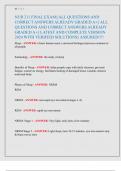1|Page
NUR 211 FINAL EXAM|| ALL QUESTIONS AND
CORRECT ANSWERS ALREADY GRADED A+|| ALL
QUESTIONS AND CORRECT ANSWERS ALREADY
GRADED A+|| LATEST AND COMPLETE VERSION
2024 WITH VERIFIED SOLUTIONS|| ASSURED!!!!
Sleep - ANSWER: a basic human need, a universal biological process common to
all people
Somnology - ANSWER: the study of sleep
Benefits of Sleep - ANSWER: helps people cope with daily stressors, prevents
fatigue, conserves energy, facilitates healing of damaged tissue wounds, restores
mind and body
Phases of Sleep - ANSWER: NREM
REM
NREM - ANSWER: non-rapid eye movement (stages 1-4)
REM - ANSWER: rapid eye movement
NREM: Stage 1 - ANSWER: Very light, only lasts a few minutes
NREM Stage 2 - ANSWER: Light sleep, lasts 10-15 minutes, eye movements stop
& brain waves slow
,2|Page
NREM Stage 3/4 - ANSWER: heart and respiratory rates drop 20-30% below
normal what is exhibited during waking hours, difficult to arouse,
Sleepwalking/talking, night terrors, no eye or muscle movement, if awakened
sleeper may be groggy, peak of growth hormone secretion
REM Sleep - ANSWER: rapid eye movements, vivid full color dreaming, brain
filters stored information about the day's activities, 20% of time for adults and 50%
of time for infants
Adult sleep cycle - ANSWER: NREM Stage 1 -> NREM Stage 2 -> NREM Stage
3 -> NREM Stage 4 -> NREM Stage 3 -> NREM Stage 2 -> REM -> NREM Stage
2
Circadian Rhythms - ANSWER: most familiar of biological rhythms, includes the
sleep/wake cycle, body temperature, blood pressure, and many other physiological
functions
Factors affecting sleep - ANSWER: Age, physical illness, anxiety/emotional
stress, environment, lifestyle, diet, exercise and fatigue, medications, alcohol and
stimulants
Insomnia - ANSWER: the inability to fall asleep of remain asleep
Acute insomnia - ANSWER: lasts one to several nights and is often caused by
personal stressors and/or worry
Chronic-intermittent insomnia - ANSWER: difficulty sleeping for a few nights,
followed by a few nights of adequate sleep before the problem returns
,3|Page
Risk factors for insomnia - ANSWER: Older age, being a woman (hormonal
changes)
Treatment for Insomnia - ANSWER: Behavioral modification, prescription
medication, OTC medication
Shift Work Sleep Disorder (SWSD) - ANSWER: a condition that affects people
whose sleep-wake and lifestyle demands are out of sync with their circadian
rhythms (graveyard shift workers)
Narcolepsy - ANSWER: a disorder of excessive daytime sleepiness caused by the
lack of the chemical hypocretin in the area of the central nervous system that
regulates sleep
Restless Leg Syndrome (RLS) - ANSWER: a familial disorder causing an
unpleasant crawling, prickling, or tingling sensation in the legs and feet and an
urge to move them for relief
Sleep Apnea - ANSWER: characterized by frequent pauses in breathing which can
last from 10 seconds to 2 minutes
Obstructive apnea - ANSWER: occurs when the structures of the pharynx or oral
cavity block the flow of air
Central apnea - ANSWER: is thought to involve a defect in the respiratory center
of the brain
Mixed apnea - ANSWER: a combination of central and obstructive apnea
, 4|Page
Symptoms of Sleep Apnea - ANSWER: Loud snoring, frequent nocturnal
awakening, excessive daytime sleepiness, difficulties falling asleep at night,
morning headaches, memory of cognitive problems, irritability, loss of functioning,
high blood pressure, increased risk of heart attack and stroke
Continuous Positive Airway Pressure (CPAP) - ANSWER: a nasal devise that is
used at the client's sleep time to help maintain an open airway
Insufficient Sleep - ANSWER: a decrease in the quality and quantity of sleep, as
well as inconsistency in the timing of sleep
Causes of insufficient sleep - ANSWER: Illness, emotional stress, medications,
environmental disturbances, variability in the timing of sleep due to shift work
S&S of insufficient sleep - ANSWER: slowed response time, blurred vision,
ptosis, decreased reasoning/judgement, decreased alertness, increased sensitivity to
pain, confusion, irritability, excessive sleepiness, hyperactive
Parasomnias - ANSWER: a cluster of waking behaviors that may interfere with
sleep
Polysomnography - ANSWER: sleep lab
Insomnia Interventions - ANSWER: create relaxing environment (temp, noise,
light, odor), provide uninterrupted periods for sleep, promote comfort, ensure
appropriate nutrition, control physiological disturbances, initiate pharmacological
interventions if ordered
Insomnia Client Teaching - ANSWER: avoid physically or intellectually
stimulating activities one hour before bedtime, exercise 20-30 minutes a day 5-6




